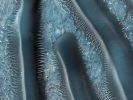It looks like you're using an Ad Blocker.
Please white-list or disable AboveTopSecret.com in your ad-blocking tool.
Thank you.
Some features of ATS will be disabled while you continue to use an ad-blocker.
share:
I always found the glass tunnels interesting although someone suggested it was probably ice.
ebtx.com...
ebtx.com...
reply to post by Rocketman7
Well they may be glass in the same way the dunes of the OP are but they aren't tunnels. They're sand dunes in gullies.
Click for full size:

Well they may be glass in the same way the dunes of the OP are but they aren't tunnels. They're sand dunes in gullies.
Click for full size:

edit on 5/4/2012 by Phage because: (no reason given)
Is this thread to early for a facepalm?
Let me know when it is please.
Yours.
TJ Hooker
Let me know when it is please.
Yours.
TJ Hooker
Originally posted by neoman789
reply to post by Phage
too bad its false color
The purpose of false color is to make some materials stand out against other materials. Blues are often assigned as a false color to some materials because it contrasts so well against the brownish-reddish-yellows of Mars.
In the case of this image, the background materials that were assigned the blue color contrast well with the yellow dunes. The result is that the dunes are easy to against the background. Otheriwse, the dunes may have been too hard to see in an "approximate true color" image.
How do they know when the dunes were created? Isn't the same outcome possible from high heat mixing with sand ie a meteor strike?
why is everyone so caught up in looking to the distant planets for life? Why not focus on understanding our own carbon based beings as well as silicon
based life forms that exist right here on Earth?
I was just watching an episode of the universe on netflix. It was about the biggest bangs in the universe. One of them was about a massive asteroid
that hit mars and carved out a a crater that was 1/3 the size of the planet. So, i'm wondering, if they knew this then, then why wouldn't it be
obvious that this is what caused it?
Originally posted by Sinny
Moons covered in glass too....fasinating, thank you!
This thread won't gain attention because there's no mention of inpediment doom! Lol
Unfortunately, you are right. A lot of posters here in ATS gravitate too much in the doom and gloom threads.
On the topic, I think NASA knows about those glass dunes a long time ago. But I would like NASA to announce at least that microbial life might have lived in Mars before.
edit on 4-5-2012 by wavemaker because: (no reason given)
Originally posted by Phage
reply to post by jonnywhite
I bet Mars is very fun for geologists or people of that ilk. (volcanologists?)
Yup.
It's a very strange place. A lot of processes similar to those on Earth but a lot of very different ones.
I thing the correct term for a Mars geologist would be aerologist.
Phage
I think theres already aerology... but its not about "out of the earth". I think...
reply to post by isyeye
Until that can be disproved conclusively, threads like this reinforce what's been long suspected. Thanks for sharing.
Until that can be disproved conclusively, threads like this reinforce what's been long suspected. Thanks for sharing.
edit on 5-5-2012 by Nightwalk because: (no reason given)
edit on 5-5-2012 by Nightwalk because: (no reason given)
Originally posted by Phage
The dunes are not made of glass. They have a high percentage of glass particles (along with other stuff).
The article has it backwards, the dunes do not lead to chemically rich water. The glass particles do not provide a perfect environment for microbial life. The conditions under which they formed (something like 2 billion years ago) indicate that there may have been liquid water available at the time (lava + water = "chemically rich water"). In other words, at the time the glass was formed conditions may have been good for the existence of life.
Volcanoes in Iceland erupt underneath glaciers, and the interactions between water from the glaciers and lava from the volcanoes create incredibly explosive eruptions. The lava fragments, and transforms into particles of glass. Huge sand dunes and sand plain fields form that consist of 50 to 70 percent glass. Horgan and Bell hypothesize that the same process occurred during periods of volcanism on Mars.
asunews.asu.edu...
edit on 5/4/2012 by Phage because: (no reason given)
Not to step on your feet Phage (I agree almost all of what you said) but I understood what was said a little differently. Assuming something huge happened that created the glass particles, this wouldn't have been a 100% conversion of materials (lava + water = glass). I'd bet there's some left over enriched water as well and the finding of the glass may lead to whatever is left (most likely frozen). I don't think they meant it would be a byproduct. OR.......I just misinterpreted your post as well.......
:::BTW this is my first reply to anything on ATS, I've been a voyeur for a few years now and decided to become more active:::
Okay so I guess I did make one other post once upon a time. My memory is impeccable!
edit on 5-5-2012 by UnendingVigilance because: Because
I'm apparently slow
This Is Really Lame On The Part Of NASA . They Know Dam Well Whats Up There Or They Are As Myopic as a Snail Needing Reading Glasses.

And I Am Really Getting Tired Of The OMG We Tink we found Water 40 years ago On Mars Yesterday Stuff..
Rant Over...
All Melted And Smooth.
It Is Interesting.

And I Am Really Getting Tired Of The OMG We Tink we found Water 40 years ago On Mars Yesterday Stuff..
Rant Over...
All Melted And Smooth.
It Is Interesting.
edit on 5-5-2012 by bluemooone2 because: (no reason given)
Hang on a cotton-picking, Creationalist debunking second!
If there is life on Mars, how could the Earth be the centre of the universe and Eve be created from Adam's rib?? '
Moreover, it raises also the age old question: was 'the serpent' an parable for a hawt shemale seductress??

If there is life on Mars, how could the Earth be the centre of the universe and Eve be created from Adam's rib?? '
Moreover, it raises also the age old question: was 'the serpent' an parable for a hawt shemale seductress??


Waste of a post, everyone already knows dinosaurs were in biblical times!
Originally posted by WonOunce
How do they know when the dunes were created? Isn't the same outcome possible from high heat mixing with sand ie a meteor strike?
Large meteor strikes produce molten glass shards when they strike areas of silica rich ground, ala sand. These shards can be very similar to Libyan Desert Glass , Modevite and Darwin Glass, caused by meteorites striking desert regions of the earth. Also, tektites are formed from impacts like this but usually huge ones, that launch the material almost in orbit, and then they fall back in globs of molten glass, producing the tektite fields we find on earth.
These fields can be far removed from the impact sites.
This is not the kind of glass that Phage was talking about, and I do not think they have ever found molten glass or tektites on the martian surface as of yet.
edit on 5-5-2012 by charlyv because: spelling , where caught
Interesting stuff. I don't see NASA going to Mars in the next decade, or so. I wonder if the retired space ship, had the capabilities of entering the
Mars atmosphere. I'm sure they will have to create one specifically for Mars, and who knows how long that will take.
new topics
-
The mysterious death of Aileen Conway
General Chit Chat: 29 minutes ago -
Half-Life 2 is 20 Years Old - its Also Free on Steam until the 18th
Video Games: 4 hours ago -
Does the Trump win mean No More Taylor Swift??
Politicians & People: 8 hours ago -
Trump-appointed judge blocks Biden administration overtime rule
Social Issues and Civil Unrest: 10 hours ago
top topics
-
Don't cry do Cryo instead
General Chit Chat: 15 hours ago, 12 flags -
Does the Trump win mean No More Taylor Swift??
Politicians & People: 8 hours ago, 12 flags -
Trump-appointed judge blocks Biden administration overtime rule
Social Issues and Civil Unrest: 10 hours ago, 7 flags -
Tariffs all around, Except for ...
Dreams & Predictions: 17 hours ago, 6 flags -
Half-Life 2 is 20 Years Old - its Also Free on Steam until the 18th
Video Games: 4 hours ago, 1 flags -
The mysterious death of Aileen Conway
General Chit Chat: 29 minutes ago, 1 flags
active topics
-
President-elect TRUMP Picks MATT GAETZ for his ATTORNEY GENERAL - High Level PANIC Ensues.
2024 Elections • 78 • : RickinVa -
Does the Trump win mean No More Taylor Swift??
Politicians & People • 45 • : Oldcarpy2 -
The mysterious death of Aileen Conway
General Chit Chat • 0 • : Shoshanna -
President-Elect DONALD TRUMP's 2nd-Term Administration Takes Shape.
Political Ideology • 208 • : fringeofthefringe -
Mike Tyson returns 11-15-24
World Sports • 67 • : argentus -
WATCH LIVE: US Congress hearing on UFOs, unidentified anomalous phenomena
Aliens and UFOs • 97 • : putnam6 -
The art of being offended
Social Issues and Civil Unrest • 52 • : argentus -
Mood Music Part VI
Music • 3703 • : underpass61 -
Old School Punk
Music • 560 • : underpass61 -
Don't cry do Cryo instead
General Chit Chat • 9 • : Myhandle
